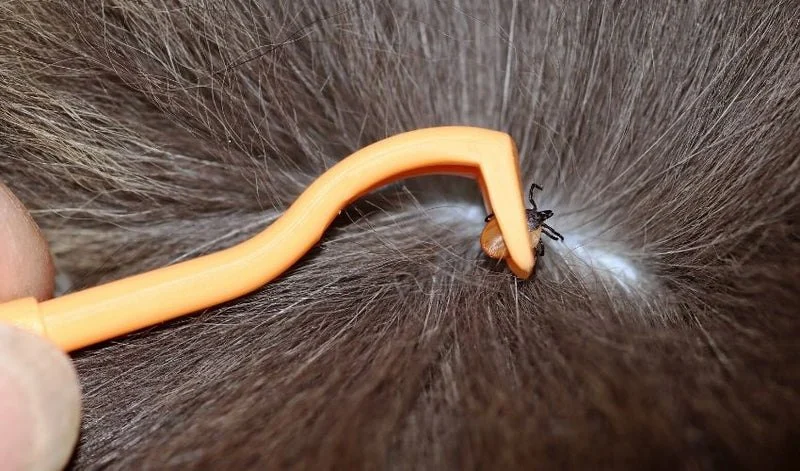
How to Remove a Tick from Your Dog Safely and Completely
- Why Tick Removal is Important for Your Dog
- Step-by-Step Tick Removal Process
- Tools You Need for Tick Removal
- What to Do After Tick Removal
- Preventing Ticks in the Future
- Real-Life Story: Successful Tick Removal and Prevention
Why Tick Removal is Important for Your Dog
Ticks are more than just a nuisance for dogs—they can transmit harmful diseases such as Lyme disease, Ehrlichiosis, and Rocky Mountain spotted fever. If not removed promptly and properly, ticks can continue to feed, increasing the risk of these diseases. Therefore, knowing how to remove a tick from your dog safely and completely is an essential skill for every pet owner.
Not all ticks carry diseases, but it’s better to err on the side of caution and remove ticks as soon as possible. Ticks can be found in grassy areas, woods, and even your backyard, so it’s important to check your dog regularly for ticks, especially after walks or outdoor adventures.

Cascade Standard poodles
Maple ValleyKing CountyWashington
20008 244th Ave SE, Maple Valley, WA 98038, USA
Step-by-Step Tick Removal Process
Removing a tick from your dog may seem like a daunting task, but with the right approach, you can do it safely and effectively. Follow these steps to ensure a successful tick removal:
1. Stay Calm and Gather the Right Tools
Before you begin, make sure you have all the necessary tools on hand. Keeping your dog calm will make the process easier, so take a few moments to relax and reassure your pet. You can use a treat to distract them and keep them still during the process.
2. Use Tweezers or Tick Removal Tools
Using fine-tipped tweezers or a tick removal tool, grasp the tick as close to the dog's skin as possible. Be sure to avoid pinching the body of the tick, as this may release harmful fluids into the wound. You want to pull the tick out with steady, even pressure without twisting, as twisting can break the tick’s body, leaving parts embedded in the skin.
3. Pull the Tick Out Slowly and Gently
Pull the tick straight out without squeezing or crushing it. You may need to pull gently for a few seconds, but don’t rush. The tick should come out cleanly. If the tick doesn’t come out easily, try to grab it again as close to the skin as possible and pull again. Avoid using petroleum jelly, alcohol, or heat to try to force the tick out as these methods can make the tick release harmful substances into the dog’s bloodstream.
4. Check for Any Remaining Parts
After removing the tick, examine the wound carefully to ensure that no parts of the tick, such as the mouthparts, remain embedded in your dog’s skin. If any parts are left behind, use a sterilized needle or tweezers to remove them. If you're unable to remove the remaining parts, consult your veterinarian for further assistance.
Tools You Need for Tick Removal
Using the right tools for tick removal is essential to ensure the process is done safely. Here are the tools you’ll need:
1. Fine-Tipped Tweezers
Fine-tipped tweezers are perfect for grasping ticks securely without crushing their bodies. Make sure the tweezers are sharp and clean to avoid infection.
2. Tick Removal Tools
Specialized tick removal tools are designed to safely remove ticks without causing harm to your dog. These tools are often more precise than tweezers and can be purchased from pet stores or online.
3. Antiseptic Wipes
After removing the tick, clean the area with an antiseptic wipe to reduce the risk of infection. Always ensure the skin is disinfected before applying any ointment or bandage.
4. Gloves
Wearing gloves while removing the tick can help prevent any tick-borne pathogens from coming into contact with your hands. This also protects your hands from any bacteria or germs present on the tick.
What to Do After Tick Removal
Once you’ve successfully removed the tick, follow these aftercare steps to ensure your dog remains healthy and the wound heals properly:
1. Clean the Bite Area
After removing the tick, clean the area with antiseptic wipes or a gentle cleanser. This helps prevent infection and keeps the area clean while it heals.
2. Monitor for Symptoms
For the next few weeks, monitor your dog for any signs of illness such as fever, loss of appetite, or lethargy. If you notice anything unusual, consult your veterinarian immediately. It’s important to catch any tick-borne diseases early to ensure your dog’s health.
3. Dispose of the Tick Properly
Don’t flush the tick down the toilet, as it may survive and crawl back out. Instead, place it in a small container with rubbing alcohol to kill it before disposing of it safely. This prevents the tick from being a risk to other pets or humans.
Preventing Ticks in the Future
While removing ticks promptly is essential, it’s just as important to take steps to prevent ticks from infesting your dog in the first place. Here are some tips to keep your dog safe from ticks:
1. Use Tick Preventative Medications
There are several tick preventative medications available, such as topical treatments, oral medications, and tick collars. Consult with your vet to find the best option for your dog based on their size, age, and lifestyle.
2. Regularly Check for Ticks
After your dog spends time outside, especially in wooded or grassy areas, check them thoroughly for ticks. Pay close attention to common tick hiding spots such as the ears, underarms, and around the paws.
3. Keep Your Yard Tidy
Ticks thrive in tall grass and wooded areas. Keep your yard well-maintained by regularly mowing the lawn, trimming bushes, and removing any leaf piles or debris where ticks may be hiding.
Real-Life Story: Successful Tick Removal and Prevention
Sarah, a dog owner in Georgia, recently discovered a tick on her Golden Retriever, Max. She followed the proper procedure for tick removal, using tweezers and carefully pulling the tick out without leaving any parts behind. Afterward, she cleaned the bite area and monitored Max for any unusual symptoms. Fortunately, Max showed no signs of tick-borne diseases, and Sarah continued to use monthly tick preventatives and checked Max for ticks after each walk. Sarah’s vigilance and quick action prevented any health issues and helped Max stay healthy and happy.
If you’re looking for the best tick prevention products for your dog, visit Omnia Pet for expert recommendations and high-quality pet care items. Our products will help keep your dog safe from ticks and other pests year-round.








 Hollywood Feed4.0 (184 reviews)
Hollywood Feed4.0 (184 reviews) Brew Biscuits5.0 (2 reviews)
Brew Biscuits5.0 (2 reviews) All Friends Animal Hospital4.0 (446 reviews)
All Friends Animal Hospital4.0 (446 reviews) Kittylandkittens LLC0.0 (0 reviews)
Kittylandkittens LLC0.0 (0 reviews) Village Animal Clinic4.0 (212 reviews)
Village Animal Clinic4.0 (212 reviews) Rift Lake Aquatics4.0 (165 reviews)
Rift Lake Aquatics4.0 (165 reviews) Understanding Pet Insurance: What Does It Actually Cover?
Understanding Pet Insurance: What Does It Actually Cover? How to Keep Your Kitten's Eyes Clean and Free of Discharge
How to Keep Your Kitten's Eyes Clean and Free of Discharge The Truth About Heartworm Disease: Prevention is Cheaper Than Cure
The Truth About Heartworm Disease: Prevention is Cheaper Than Cure Why Is My Kitten's Belly Button Showing? | Omnia Pet
Why Is My Kitten's Belly Button Showing? | Omnia Pet Why Does My Cat Bite Me Gently? Love Bites Explained
Why Does My Cat Bite Me Gently? Love Bites Explained How to Stop Your Kitten from Getting into Cabinets
How to Stop Your Kitten from Getting into Cabinets